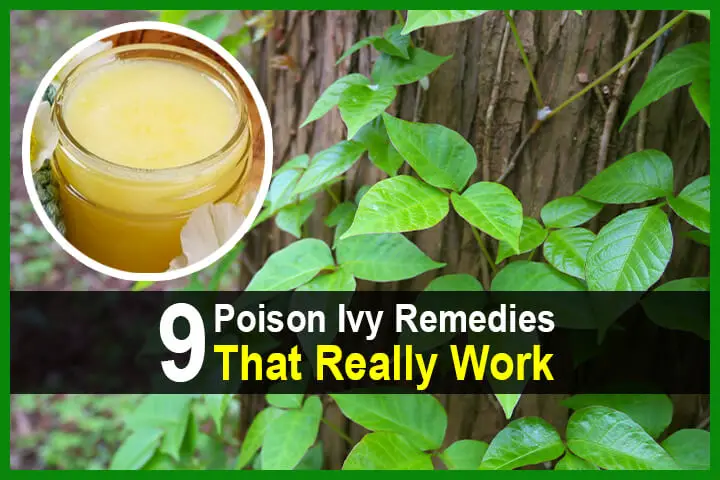Estimated reading time: 8 minutes

If you are sensitive to poison ivy, oak, or sumac, a hike in the woods or even a walk in the park can turn into a nightmare. You might suffer from a severe rash that includes blisters, swelling, and itching. In some cases, an adverse reaction can lead to difficulty breathing.
Although these symptoms typically improve without treatment within one to three weeks, they can add up to pure misery until then. This article explores what causes the rash and how to avoid it, home remedies that work, and when to seek medical help.
Want to save this post for later? Click Here to Pin It On Pinterest!
What causes poison ivy rash?
Physical contact with urushiol, an oil within the plant, is the culprit behind a poison ivy, oak, or sumac reaction. Although some people can touch urushiol and not react to it, others are not as fortunate and notice symptoms 12 to 48 hours after exposure.
The severity of the rash depends on how much urushiol gets on your skin. The oil is in the plant’s leaves, stems, and roots, so a reaction may develop even if you brush against the plant. Sensitive people can even get a nasty reaction by touching clothing that has the oil on it or a pet that has the oil on its fur.
Also, you can unknowingly spread the rash to other parts of your body – like your face – with your hands.
How to Protect Yourself
The best defense is a strong offense. In other words, there are ways to recognize and avoid poison oak, ivy, and sumac.
- Remember the adage “Leaves of three, let them be.” These poisonous plants have three glossy leaves that are either smooth or notched.
- The plants grow as a vine or a small shrub.
- The leaves change color seasonally, meaning they are reddish in the spring, green in the summer, and yellow, orange, or red in the fall. Some plants boast small white berries or green and white flowers.
- Wear protective clothing – long pants, socks, gloves – in areas where poison ivy may grow.
To help you identify them, here are some pictures.
Poison Ivy

As you can see, poison ivy is characterized by its clusters of three pointed leaves. The leaves can vary in color from green in the spring and summer to a vibrant red or yellow in the fall.
The surface may be smooth or slightly hairy, and the plant itself can grow as a vine or a shrub. This adaptability allows it to thrive in a variety of environments, often along edges of woods, in open fields, and along roadside areas.
Poison Oak

Poison oak can be identified by its leaves, which are typically arranged in clusters of three, resembling the shape of oak leaves. The edges of the leaves are scalloped or lobed, giving them a wavy appearance.
The color transitions from green in spring and summer to shades of red or bronze in the fall. This plant usually grows as a dense shrub in wooded areas, particularly along the West Coast of the United States.
Poison Sumac

Unlike poison ivy and poison oak, poison sumac grows as a tall shrub or small tree and is noted for its stems which have 7 to 13 leaflets arranged in pairs.
The leaves are smooth, elongated, and have pointed tips, appearing a glossy green during the spring and summer and turning a striking red or orange in the fall. Poison sumac tends to thrive in wet, swampy areas, making it less common along trails and more common in wetlands.
What To Do If You Touch Poison Ivy
Timing is crucial if you have been exposed to poison ivy, oak, or sumac. Washing your skin as soon as possible can significantly reduce symptoms. Use heavy gloves to remove any exposed clothing and place them in a plastic bag. Then, shower or wash yourself thoroughly with lukewarm water and soap. Avoid hot water as it can irritate your skin further.
Urushiol can remain active a year or more after exposure. So, after showering, dump the exposed clothing directly into the washing machine and wash with detergent in hot water, making sure the clothes can agitate freely. Be sure to discard the plastic bag.
Also, bathe an exposed pet – wearing heavy gloves – and wash any gardening tools, backpacks, water bottles, or other items that may have been exposed.
How to Treat a Poison Ivy Rash
When it comes to home remedies, you are looking to soothe the itching, dry an oozing rash, and reduce the chance of infection. Although a severe rash will still run its course, here is a list of treatments that will help you feel more comfortable as it does.
1. Rubbing Alcohol
Carrying alcohol wipes with you on a camping trip or a hike can be a game-changer when it comes to preventing a full-blown poison ivy rash. Rubbing alcohol can remove the urushiol from your skin and other surfaces. However, avoid using rubbing alcohol after a rash has appeared as it can further irritate skin.
2. Cold Compress
Applying cool, damp compresses to the affected areas can provide relief from itching and pain. Brief, cool showers also can help.
3. Aloe Vera Gel
Pure aloe vera is another option. You can remove the soothing gel right from an aloe vera plant, or you can buy aloe vera gel online or at a pharmacy and apply it to the rash for temporary cooling and soothing relief.
4. Oral Antihistamines
Oral antihistamines (such as Benadryl) can help reduce inflammation and itching. Be aware, though, that these products can produce drowsiness. (Note: Over-the-counter antihistamine ointments may make the rash worse.)
5. Colloidal Oatmeal
Colloidal oatmeal, which is made by grinding oat grains into a fine powder, has anti-inflammatory properties that can help relieve rash symptoms. Taking an oatmeal bath or applying colloidal oatmeal directly to the rash can offer soothing relief.
6. Baking Soda
Baking soda (sodium bicarbonate) is a soothing natural remedy worth trying. You can add it directly to lukewarm bath water or make a paste with it and a bit of warm water. Apply the paste to the affected areas, allowing it to sit for five to 10 minutes before gently washing away.
7. Bentonite Clay
Another option is to make and apply a paste of bentonite clay (also called absorbent aluminum phyllosilicate clay or Montmorillonite clay) and water to the rash. Here’s information on this form of clay and how to use it.
8. Calamine
Calamine, often called calamine lotion, is a pink liquid made from powdered calamine mineral. You can help soothe irritated skin and relieve itchiness by applying this mild lotion.
9. Apple Cider Vinegar
The hurry is out on this remedy. Some people report that the acid in apple cider vinegar helps dry up a poison ivy rash and relieve itching. However, research on this remedy is inconsistent.
Most poison ivy, oak, and sumac rashes run their course and clear up within a few weeks without needing a health professional’s attention. In some cases, however, you may need to see a doctor. Here are some warning signs:
- The person experiences breathing difficulty.
- The rash spreads to the point of affecting, covering 25% or more of the body.
- The itching worsens, significantly disrupting sleep.
- The rash affects the eyes, inside the mouth, or genitals.
- Symptoms do not show improvement after seven to 10 days.
- The person has a fever above 100°F, indicating a possible infection.
For more information on identifying and avoiding poison ivy, oak, and sumac, check out this video from Oklahoma State University and this article from Alabama and Auburn Universities Extension Service.
Like this post? Don’t Forget to Pin It On Pinterest!

Read the full article here




